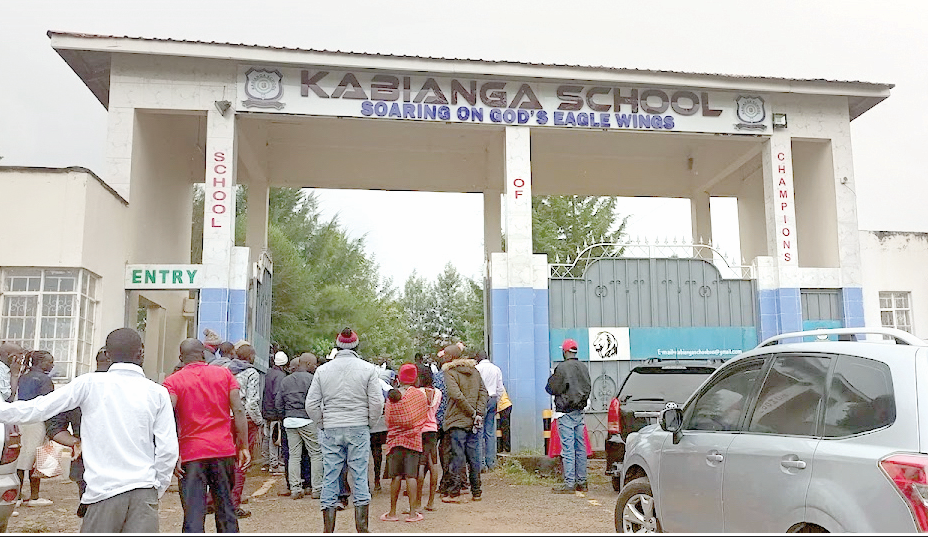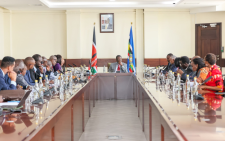Big scramble for Form One places in select schools

Kabianga and Nanyuki High are the most preferred secondary schools among pupils who sat Class Eight examinations this year.
This is the third year in a row the two institutions have been selected by the highest number of learners seeking to join Form One.
This came out when Education Cabinet Secretary Ezekiel Machogu announced the completion of the Form One selection in Nairobi, yesterday. Learners will be expected to join their respective schools on January 15.
According to Machogu, 186,357 candidates selected Kabianga as their first choice, yet it has a capacity of 672 students. Nanyuki, with a capacity of 480 learners, received 158,741 applicants.
Pangani Girls is the third most sought after school. It received 144,542 applicants yet it is only able to absorb 384 learners. It was followed by Kapsabet Boys with 143,723 applicants against a capacity of 432.
The fifth most selected school was Alliance Girls High School, which had 135,033 applicants against a capacity of 384. Maseno School followed with 123,777 applicants against 672 available slots.
Nakuru High School had 115,513 applicants although it can only absorb 480, while Butere Girls had 114,635 applicants competing for 480 slots.
Academic giants Mang’u High and Alliance High schools followed with 112,938 against a capacity of 480 and 110,839 applicants competing for the 384 available seats, respectively.
As a rule, all Kenya Certificate of Primary Education (KCPE) candidates are expected to select at least two national schools they would wish to be admitted to for Form One. The learners select the schools before sitting the exams. The selection does not take into account a candidate’s strengths and weaknesses.
“As we reflect on the 2024 Form One placement results, it is important to remember that the choices made by the candidates themselves played a significant role in the outcome,” CS Machogu said. “Candidates were placed in schools largely based on merit and choice,” said the CS, when he released the Form One selection results at Lenana School, Nairobi.
He said some candidates could not be placed using this criterion and had to be placed in schools of equivalent standing outside their counties. These included learners from counties with inadequate capacity.
“During the placement, my attention was drawn to a specific issue that is worthy of the mention. Some candidates, despite having high scores, did not make any school choices.
A total of 28,052 candidates abstained from selecting schools in various categories; national (222), extra-county (4,837), county (8,716) and sub-county (14,277).
Special needs
Among these were 683 candidates from Wanjohi sub-county in Nyandarua and 330 from Kopsiro sub-county in Bungoma.
“This situation presented us with a dilemma, as we sought to ensure that every candidate had a placement that would enable them to continue their education seamlessly,” the CS said.
To accommodate those who abstained, a decision was reached to place them in public sub-county secondary schools nearest to their former primary schools.
All candidates who scored 400 marks and above were placed in either National or Extra County schools of their choice.
Similarly, all other candidates were placed in county or sub-county schools in line with the set parameters while learners with special needs were placed either in regular or special needs schools based on their disability categories, merit and choices.
Overall, 42,927 students who sat this year’s KCPE were placed in national schools. Out of these, 22,051 are boys and 20,876 girls. Some 274,746 students will join Extra county schools. Of these, 141,590 are boys and 133,156 are girls. Another 288,201 have been placed to county schools.
Sub-county schools will have the lion’s share of Form One admissions at 792,230 out of which 423,171 are boys and 369,059 are girls. Another 2,225 learners will be admitted to Special Needs Schools.
The Ministry of Education has continued to apply affirmative action to cater for needy and vulnerable children in slums and informal settlements in urban areas, in compliance with the government’s policy of achieving parity in education.
Last exam
Through affirmative action, the Ministry placed 130 learners in national and 167 in extra-county schools, with 150 of the beneficiaries being girls and 147 boys.
Besides the affirmative action on needy and vulnerable children, the placement also considered the 2017 Djibouti Declaration on Regional Refugee Education and placed learners from primary schools in refugee camps.
This year, the number of KCPE candidates rose by about 180,000 to hit a historic high of 1.41 million, a surge attributed to the fact that this was the last class under the 8-4-4 system. That meant this year offered the last chance for all those who wanted to sit the KCPE examination to do so.
This, Machogu said, created a placement challenge in counties where there were insufficient secondary schools and, as a result, some learners from these regions were placed in schools in neighbouring counties.
As a result, at least 62,007 candidates were placed in neighbouring counties, with Nairobi having the highest number at 27,995.
Kwale followed with 9,185, while Narok was third with 8,236. Kilifi with 7,800, Mombasa, Kajiado and Isiolo with 4,662, 3,396 and 733 respectively followed in that order.
“In this connection, and to mitigate the acute shortage in Nairobi, the government has started construction of 3,500 classrooms,” said the CS.
This time, the candidates were not sending short messages to check where they have been placed. Instead, the CS said the results would be obtained from the Ministry’s website, where the candidates can view their results and download instructions on how to apply for admission.
Upon downloading the joining instructions, the candidate must present the letter to the head teacher of the primary school where they sat their KCPE for authentication.
The letter will thereafter be verified by the principal of the admitting school. Principals have been advised to ensure that letters presented to them belong to learners who will strictly be on their selection list.
Primary and secondary schools can access their selection lists from the National Education Management Information System (NEMIS) platform. Admissions will also be done online through NEMIS.
Machogu stated that the Ministry had developed a reporting module that the principals will use in both public and private schools to relay the admission of each learner online.
“This will provide real-time data on admission and reporting trends to facilitate decision-making. Principals will be responsible for the accuracy, security and integrity of their school data on NEMIS,” he said.
In the past, Machogu said, the Form One selection and placement was a manual and decentralised process and principals would convene at various levels, starting with national meetings, followed by provincial gatherings, and finally district selection and placement meetings.
Joining instructions
During the selection, principals would pick candidates manually under the guidance of education officers and then generate lists for their respective schools, then prepare joining instructions for onward transmission to primary schools where the candidates collected them.
“This manual approach was resource-intensive, time-consuming and prone to corruption. The approach also lacked objectivity and would sometimes lead to loss of admission letters,” Machogu said.
With advancements in technology and the Ministry’s adoption of digital systems, the process has undergone major changes and a candidate can now find out where they have been placed with a click of a button as soon as the results are announced.
The first computerised placement of KCPE candidates at the national level was carried out in 2006 and progressively extended to extra-county and county schools by 2016 and to sub-county level by 2020.
Even with computerisation of the selection, the preparation of joining instructions continued to be manual until 2017 when the Ministry started uploading joining instructions online.
Yesterday, the CS urged parents and guardians to take advantage of this system to download their letters online without having to depend on middlemen.








